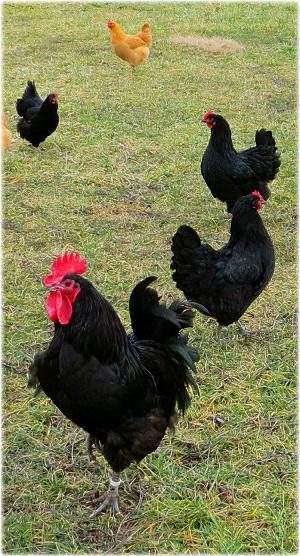Fresh eggs and chemical-free meat are two good reasons to raise backyard birds. Keeping a small flock of chickens also provides plenty of nitrogen-rich manure for the garden and natural bug control for your yard.
Backyard chickens are common in rural areas, but chicken farming is becoming increasingly popular in urban areas. As a result, many city ordinances have amended laws that allow residential coops. Most ordinances dictate a maximum of six hens, no roosters, and require the chicken coop be 15 to 100 feet from the house. Some require permits. Check your local regulations.
Determine which breed to buy
Hundreds of chicken breeds exist. Some breeds are better for meat, others for eggs. Mail order poultry catalogs identify several breeds as “dual-purpose.” My experience has been that the meat from dual-purpose birds is inferior to meat from broilers.
Different chicken breeds lay different colors of eggs. Interesting fact: the color of a hen’s earlobes tells what color egg it lays. Although all egg colors taste the same and contain the same nutrition, a multicolored carton of brown, green, blue and white eggs has a beautiful effect. If you have an egg color preference, choose a breed of laying hen accordingly.
Best time to raise chicks
You can buy chicks through mail order any time of year, but if you plan to keep them outdoors, warm weather makes it easier to maintain a 90-95 degree environment the first week. After week one, gradually lower the temperature by five degrees for five weeks to help chicks acclimate to an average temperature of 70 degrees. Once chickens have traded their baby fluff for full feathers they do not need supplemental heat.
The brooder
Chicks live their first 8-10 weeks of life in a brooder box. If you are only raising a few hens, you can use a large cardboard box as your brooder. Hang a 250 watt heat lamp a safe distance from the cardboard edges to achieve a temperature of 90-95 degrees. Fill the box with bedding, chick feed and fresh water. I add powdered electrolytes to their water for the first week of life to help chicks recover from transit and maintain hydration.
The coop
An average laying hen requires only 1.5 sq. ft. of indoor space and 8 sq. ft. outdoors. My free range chickens enjoy much more. Factory farmed chickens are given much less. If your space is limited, consider mini Bantam breeds that require only 1 sq. ft. of indoor space and 4 sq. ft. outdoors.

People fashion creative coops out of everything from old car frames to discarded playhouses. If you’d like a look at my coop check it out here.
Whatever shape coop you design, it is necessary to include a roost and nesting boxes. Fourteen hours of light each day and good ventilation are critical to keeping layers healthy and productive. Food, water and clean bedding make the coop a home-sweet-home for chickens.
Production
Hens start to lay eggs when they are 20-25 weeks old. They reach peak production at one year old. The amount of eggs laid decreases every year thereafter. Chickens can live over 10 years, but a typical natural lifespan is closer to five years.














See my FB comments. Your comments regarding “chemical free meat” and Factory farming. I suggest you figure that there are a lot of family farmers in NE ohio that raise commercial poultry. If you know the law you would also know know that chemical aren’t allowed in meat, chickens are checked for that and the farmer is not paid if traces are found, so there is no way a farmer will work hard to produce a crop and then ship contamiated product to market. As for “factory farms”. All of the broilers and egg layers in nE Ohio are raised by farm families, not corporations GET YOUR FACTS STRAIGHT>
Since you’re so adamant about fact-checking, I did a little digging to find out if your statement that all chemicals are banned in the production of chicken meat was true. As I suspected, this isn’t true. For one thing, there are several drugs approved for use in poultry that are not approved for human consumption, in addition to the sub-therapeutic application of antibiotics that is prevalent in chicken farming. Furthermore, commercially-produced chicken meat has tested positive for the presence of arsenic–which for some bizarre reason, is approved for use in non-organic chicken farming. There are plenty of chemicals approved for use in chicken production, so I don’t know why you would say otherwise.
You may be confusing “chemicals” with “hormones”, since many companies boast that their meat or eggs are “hormone free” despite the fact that there are no hormones approved for use in chickens in the USA. Wanting to raise “chemical free” meat is actually a very legitimate reason to start raising backyard poultry.
I don’t believe Farm and Dairy would publish anything intended to hinder the productivity of the family farms that raise birds for the comercial market.
I keep a small flock of chickens for a hobby and do a little showing. I often have extra birds to sell. I have learned of the trend raise your own food through questions I am asked from potential buyers. This article didn’t say free of illegal chemicals. Antibiotics are chemicals for example. Crops used for feed are sprayed with chemicals not to mention genetically altered. I feed commercial feed and there are people who don’t want them because of that. I don’t use medicated chick starter and there are people who seek them out because of this. There are others who just want to raise their own chickens for various reasons and not unlike myself, aren’t overly worried about where their chicken feed comes from. I agree that wanting to raise “chemical free” meat is a legitimate reason to raise your own meat. It is not the reason I raise my own birds but I respect those who do.
I also want to point out that the statement about the color of the earlobe and egg color is not 100% correct. It is good for reference and correct for common breeds but if egg color is important to you, research the breeds you are considering to be sure.